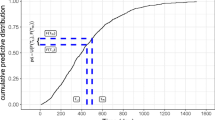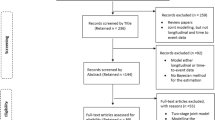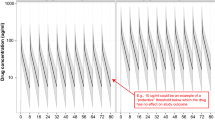Abstract
It is not uncommon that the outcome measurements, symptoms or side effects, of a clinical trial belong to the family of event type data, e.g., bleeding episodes or emesis events. Event data is often low in information content and the mixed-effects modeling software NONMEM has previously been shown to perform poorly with low information ordered categorical data. The aim of this investigation was to assess the performance of the Laplace method, the stochastic approximation expectation–maximization (SAEM) method, and the importance sampling method when modeling repeated time-to-event data. The Laplace method already existed, whereas the two latter methods have recently become available in NONMEM 7. A stochastic simulation and estimation study was performed to assess the performance of the three estimation methods when applied to a repeated time-to-event model with a constant hazard associated with an exponential interindividual variability. Various conditions were investigated, ranging from rare to frequent events and from low to high interindividual variability. The method performance was assessed by parameter bias and precision. Due to the lack of information content under conditions where very few events were observed, all three methods exhibit parameter bias and imprecision, however most pronounced by the Laplace method. The performance of the SAEM and importance sampling were generally higher than Laplace when the frequency of individuals with events was less than 43%, while at frequencies above that all methods were equal in performance.





Similar content being viewed by others
References
Harville DA, Mee RW. A mixed-model procedure for analyzing ordered categorical-data. Biometrics. 1984;40(2):393–408.
Stiratelli R, Laird N, Ware JH. Random-effects models for serial observations with binary response. Biometrics. 1984;40(4):961–71.
Cox EH, Veyrat-Follet C, Beal SL, Fuseau E, Kenkare S, Sheiner LB. A population pharmacokinetic-pharmacodynamic analysis of repeated measures time-to-event pharmacodynamic responses: the antiemetic effect of ondansetron. J Pharmacokinet Biopharm. 1999;27(6):625–44.
Plan EL, Karlsson KE, Karlsson MO. Approaches to simultaneous analysis of frequency and severity of symptoms. Clin Pharmacol Ther. 2010;88(2):255–9. doi:10.1038/clpt.2010.118.
Jonsson S, Kjellsson MC, Karlsson MO. Estimating bias in population parameters for some models for repeated measures ordinal data using NONMEM and NLMIXED. J Pharmacokinet Pharmacodyn. 2004;31(4):299–320.
Lin X, Breslow NE. N.E. Bias correction in generalized linear mixed models with multiple components of dispersion. J Am Stat Assoc. 1996;91:1007–16.
Rodriguez G, Goldman N. An assessment of estimation procedures for multilevel models with binary responses. J R Stat Soc, Ser A Stat Soc. 1995;158:73–89.
Lavielle MaS, R.M. A new SAEM algorithm for ordered-categorical and count data models: implementation and evaluation. PAGE 18 (2009) Abstr 1526 [wwwpage-meetingorg/?abstract=1526]. 2009.
Lavielle M. Monolix user's manual. 31st ed. Orsay: Laboratoire de Mathematiques, U. Paris-Sud; 2007.
Bauer RJ, Guzy, S. Monte Carlo parametric expectation maximization method for analyzing population PK/PD data. In: D'Argenio DZ, editor. Advanced methods of PK and PD systems analysis. 2004. p. 135–63.
Bauer RJ. S-ADAPT/MCPEM user's guide. CA: Berkeley; 2008. Version 1.56.
PDx-MCPEM User's Guide. 2006.
Bauer RJ, Guzy S, Ng C. A survey of population analysis methods and software for complex pharmacokinetic and pharmacodynamic models with examples. AAPS J. 2007;9(1):E60–83. doi:10.1208/aapsj0901007.
Dempster AP, Laird NM, Rubin DB. Maximum likelihood from incomplete data via Em algorithm. J R Stat Soc B Methodol. 1977;39(1):1–38.
Beal SL, Sheiner LB, Boeckmann A, Bauer RJ. NONMEM user's guide (1989–2009). Ellicott City: Icon Development Solutions; 2009.
Beal SL, Sheiner LB, Boeckmann A, Bauer RJ. NONMEM User's Guide—Introduction to NONMEM 7. Ellicott City: Icon Development Solutions; 2009.
Beal SL, Sheiner LB. NONMEM user's guide—part VII: conditional estimation methods. Ellicott City: Icon Development Solutions; 2009.
Pinheiro JC, Bates DM, Lindstrom MJ. Model building for nonlinear mixed effects models. American Statistical Association 1994 Proceedings of the Biopharmaceutical Section. 1994: 1–8 522.
Delyon B, Lavielle V, Moulines E. Convergence of a stochastic approximation version of the EM algorithm. Ann Stat. 1999;27(1):94–128.
Lindbom L, Ribbing J, Jonsson EN. Perls-speaks-NONMEM (PsN)—a Perl module for NONMEM related programming. Comput Meth Programs Biomed. 2004;75(2):85–94. doi:10.1016/j.cmpb.2003.11.003.
Ueckert S, Johansson ÅM, Plan EL, Hooker AC, Karlsson MO. New estimation methods in NONMEM 7: evaluation of robustness and runtimes. PAGE 19 (2010) Abstr 1920 [wwwpage-meetingorg/?abstract=1920]. 2010.
Author information
Authors and Affiliations
Corresponding author
Appendix
Appendix

Rights and permissions
About this article
Cite this article
Karlsson, K.E., Plan, E.L. & Karlsson, M.O. Performance of Three Estimation Methods in Repeated Time-to-Event Modeling. AAPS J 13, 83–91 (2011). https://doi.org/10.1208/s12248-010-9248-3
Received:
Accepted:
Published:
Issue Date:
DOI: https://doi.org/10.1208/s12248-010-9248-3




